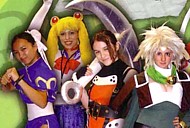
Otaku Unite!
As an anime collector since the airing of Robotech in 1985, I've lived through about 21 years of fandom. I've been an anime fan for longer than many current anime fans have been alive. For me, it's not a statement of pride, just a statement of fact. Although I've been aware of the otaku label for a long time, it's not quite something that ever suited me. Back in the late '80s and early '90s when I started collecting in earnest, I was fully aware of the fact that I was a teenager watching animated programs from Japan with 20-to-40 something males who did not appear to bathe regularly, still lived at home, and sometimes spent huge amounts of brainpower learning the minutiae of programs they'd never even had the chance to watch. To be an otaku, it seemed that one had to be OCD, just with the focus of the OCD on anime. I loved my hobby, but the term never really fit.
How things have changed, and how they have stayed the same.
Otaku Unite! is a 70-minute documentary created from footage from 2000-2002 (but just released officially in early 2006 by Central Park Media) that attempts to capture the spirit of the American otaku. It is, in essence, is a documentary about the kind of folks who I expect visit this website on a regular basis. It's already a bit dated and on the simplistic side at times, suffering from too short a running time and the ugly look of digital videocameras, but Otaku Unite! is the only program I've ever seen that grasps what it means to be an otaku in the US. It not only presents a good look at anime from the perspective of the experts, it gleefully serves up both sides of fandom -- the normal folks fascinated by the storytelling and artistic skills of the west, as well as the freaks who have made anime their life (apparently because they couldn't find another one).
Otaku Unite! starts by trying to define what an otaku is, explaining its origins in the Japanese language and how it got transported over here as a term of respect for fans rather than a term of derision. The documentary then moves into a brief explanation of the roots of anime in the US, interviewing notable folks such as Helen McCarthy, Gilles Poitras, Fred Patton, Trish Ledoux, and Carl Macek. After explaining how anime got off the ground, it's off to the conventions we go, which is the heart of the film. Otaku Unite! is about relating just a bit of the experience one has running into grown men dressed as scantily clad women, as well as the cosplay contests, the dances, and other events that make up the typical convention. It's here that we see the best and worst of anime fandom in action. Whether it's the dance troupes that perform numbers from the Sailor Moon musicals, the first otaku wedding, or seeing the first stateside yaoi convention, Otaku Unite! presents it, warts and all.
What makes this documentary work is the fact that the film is willing to show the best and worst of the anime scene. For example, there is one central anime fan that the program follows -- "Johnny Otaku," a guy who does an anime-themed radio show at the local college. He's the prototype for Napoleon Dynamite. He is a geek through and through, and though he seems to know this, he certainly doesn't appreciate just how bad it makes him appear. Whether he's trying out different voices so that he can someday become an actor in American dubs or calling the jury at a cosplay contest "rigged" because his bizarre striptease skit didn't win, the documentarians do not shrink from showing him as strange and slightly pathetic. There is no voiceover; the pathos is evident from the footage alone. And if "Johnny" isn't enough, there are grown men play-acting as little girls. It's funny in a really disturbing sort of way. It's these folks that have kept me from becoming a part of the otaku circuit, but that's just me. If nothing else, Otaku Unite! nails these folks just as they are.
The other great thing is being able to put a face with a name. I've read books by every author interviewed in this program. I had conversations with Carl Horn (one of the many talking heads in the show) back in 1992 when the Internet lines of communication were limited to the rec.arts.anime newsgroups. I met and essentially interviewed Steve Bennett, the goofy Hooters-loving line artist on Urusei Yatsura, at C-Kon 2002. I remember the writings of Trish Ledoux from the old days of Animag. These folks are the ones that I relate to the most in anime fandom. That isn't to say that I'm close to their caliber of achievement; these are the folks that I truly respect and see as mentors of a sort. The fact that Otaku Unite! got all these folks on tape is impressive, and if you know who they are, it is a uniquely wonderful experience.
But the problems also lie in this same vein. The anime world has changed drastically in the five years since this movie's footage was all but complete. Sure, there's a section on the Internet's influence on anime, but it's limited to a brief bit on the Anime Web Turnpike. Yep, that's it...has anybody used that site in years? It was once, admittedly, the place to find everything and anything related to anime. But it was sold years ago and has never been the same since. Where is Chris Beveridge and his wildly important Anime on DVD? Where is the gang over at Anime News Network? Already, this documentary is about fandom as it stood several years ago, not now. There's no mention of the impact of cable networks picking up huge shows like Cowboy Bebop...no discussion of the even bigger conventions that hit in the last two years...no thought of exploring the slow decline we've seen in the American anime market in 2005-2006. It's a great snapshot, but one that's already in need of updating.
There's also the problem of the intended audience. For my love of seeing a few of my personal anime fandom heroes, my wife (and any other non-fan) is going to look at Carl Horn or Fred Patton and think, "Who the heck is he?" As a brief interview with the voice actors from the original Speed Racer mentioned, it's only at anime conventions that people know and love them. Those who might get the most out of watching Otaku Unite! may just not get it, especially since there is a huge gap in explaining how anime in the US evolved from the early days of Robotech and Streamline Pictures to its point of saturation in the early part of the 21st century. Meanwhile, though the vast majority of current fans don't know the history of anime, they also don't care. This leaves me in the lurch to explain who will like this documentary.
The ultimate answer is, I did. Not only did it give me some time with folks I really respect in the anime industry, it showed me that I'm not crazy in avoiding certain aspects of fandom. It showed a realistic portrait of the anime world in the time period when it was made. Though it's unfortunate that it's being released to the general public nearly three years after its completion, I'm impressed at the level of dedication to fandom that it took to create it. For the first serious documentary about a subject dear to my heart, it's good. It won't change the anime community, but I'm glad I got to see this portrait of the fandom that I both love and hate.
Otaku Unite! -- nothing objectionable (except some funny looking crossdressing) -- B+

